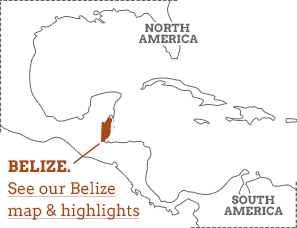A brief history of Belize
You just need to look at the delightfully diverse demographics of Belize to get a quick overview of this country’s history. First of all, the national language is English, a hangover from its years of British colonial rule, when they took over from the Spanish who had claimed it as part of their Central American Territories. Defeating the Spanish first in 1798, at the Battle of St. George's Caye, and then formally declaring British rule, they renamed it British Honduras in 1862. It remained a British colony until 1981 and is still a Commonwealth member.
Read more
Nearly 50 percent of Belize’s population describes itself as Hispanic, and indeed the Spanish first started moving into Belize in 1506. However, they found it difficult to settle, as the resistance from the indigenous Mayan people was very strong, culminating in a massive rebellion in 1546. Battles between the Spanish, already settling the rest of the Yucatan Peninsula, and the Mayan people continued for over two centuries, resulting in outright destruction of Mayan homes, people and their culture. In the middle of this battle for survival, a plague of locusts and ensuing famine almost wiped out the Mayan people altogether between 1627-1630. Indeed, today it remains the most sparsely populated country in Central America. Just over 10 percent of the current population is Mayan, divided into three groups: The Yucatec, originally from the Yucatan, the Mopan, indigenous to Belize and Kek'Chi who fled from slavery in Guatemala in the 19th century.
British colonisation brought other issues of course, the main one being slavery. Before the British formally took over Belize, they were granted logging rights by the Spanish, and for this purpose they introduced slaves and indentured servants, mostly originating from African countries. These logging masters became known as ‘baymen’. Today, Kriols make up roughly 21 percent of the Belizean population, Kriols being descendants of these slaves or, in some cases, of the Baymen slave owners too. In 1838, when emancipation was declared, freed slaves made up half of Belize’s population and today the Kriol culture is a vibrant and important part of Belizean life, with the Kriol language, invented during the years of slavery, now spoken by 75 percent of Belizeans. And all this before British claimed the land as its own in 1862.
Belizean soldiers fought for the British during WWI after which the country, along with so many across the world was hit by the 1930’s Depression. It was also hit by one of the most destructive hurricanes ever to strike Belize, in 1931, killing around 2,500 people and wiping out Belize City. The following couple of decades saw Belizeans becoming very active politically, as they fought for economic survival, with trade unions and suffrage movements taking hold. This led to constitutional reforms of 1953 which gave the country limited autonomy, when the general election was won by People's United Party (PUP), led by George Price. He then went on to work towards full autonomy, which was granted in 1964 as well as, most importantly, universal adult suffrage. Price stayed in power and become Prime Minister when the country was finally declared independent in 1981. Tension with neighbouring Guatemala over territorial claims had been ongoing for years, however, and they refused to recognize the newly named Belize until 1992, with British troops remaining in situ to protect its former colony. The dispute still remains unresolved and is currently in the hands of the International Court of Justice (ICJ).



